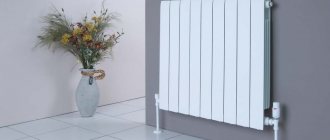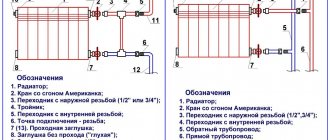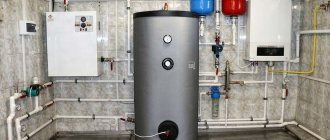Features of the diagonal connection scheme
If you also wondered why a diagonal connection is the most effective, then you should consider this option in more detail. If we take into account the process where hot air or water is involved, then the action will occur according to one physical law, which involves the rise of warm masses upward, while the cold ones sink downwards.
To ensure uniform heat distribution throughout the volume of the radiator, the coolant should be distributed throughout the battery. As mentioned above, lateral connection in city apartments acts as the main circuit. After all, forced circulation under high pressure is used there. The diameter of the incoming and outgoing pipes is only 20 mm. Through them, water enters the battery under high pressure, which allows the device to be filled evenly and quickly.
If we are talking about private housing construction, where the circulation is natural, the filling of radiators occurs under the influence of the above-mentioned physical law. That is why hot streams penetrate through the upper pipe, pushing cold water through the lower outlet on the opposite side. The two pipes are located diagonally when viewing the device. This is where the name of the connection comes from. The coolant fills the battery gradually, releasing heat to the entire volume. It is necessary to take into account not only the law of heat transfer, but also the physical law. That is why this scheme is the most effective.
Diagram of a two-pipe system
The basis of a two-pipe heating system is two pipes. Through one, heated water enters the batteries, through the other, cooled water is removed from them. Heating is produced by any heat source - heat pump, boiler, boiler.
If the connection of heating radiators with a single-pipe heating system is serial and the water cools down as it passes through the radiators, then with a two-pipe heating system it is parallel and the heating is more uniform.
The difference between a two-pipe heating system and a single-pipe one is that it heats all radiators almost evenly. Small heat losses are possible due to the distance from the heating device - the longer the water flows through the pipe, the more it cools.
Diagram of a two-pipe heating system.
Features of the implementation of the diagonal scheme
You can implement the diagonal connection of the heating radiator yourself. Work should begin with preparing the battery. To do this you need to make sure you have:
- heating devices themselves;
- shut-off valves;
- pipes;
- fittings;
- other additional devices such as heat meters, Mayevsky tap and thermal head.
At the first stage of the work, a radiator is installed. In this case, it is necessary to take into account the rules. This is due to the fact that the efficiency of heat transfer will depend on them. When a diagonal connection of a heating radiator is used, part of the window opening must coincide with the axis of the radiator. It is necessary to maintain a distance of 15 cm from the window sill to the upper collector. As for the step from the floor to the bottom of the collector, it should be the same. There must be a distance of 5 cm from the wall to the battery. Errors may occur. If we are talking about the distance to the window sill or floor, then the error can reach 4 cm, while the step between the battery and the wall can be increased or decreased by 1 cm.
If you decide to use a diagonal connection to the heating radiator, you must take into account some assumptions that will affect the intensity of heat transfer. For example, if there is no window sill in the room, then this figure can be increased by a maximum of 20%. Bringing the battery closer to the floor will reduce heat transfer by 7%. To increase the efficiency of heat transfer, professionals recommend supplementing the radiator with a reflective screen that is mounted on the wall. For this you can use a sheet of fiberboard or cardboard, each of which is covered with foil. In this case, heat transfer can be increased by 25%.
Installation of consumers: where to place
In houses and apartments, batteries are placed under windows, which is done for a reason. Cold air moves from the windows, which is cut off by the heat emitted by the radiators. This way, the penetration of cold air into the room is prevented, convection is improved, and condensation does not form on the glass.
For the radiator to function effectively, the battery must occupy at least 70% of the width of the window opening.
It is also recommended to place the heat exchanger centrally opposite the window opening, which is not only beautiful in terms of design, but also allows you to effectively cut off cold air. It is important to take into account another factor - the height of the radiator. The optimal height value (from the floor to the bottom of the radiator) is around 8-12 cm. If the floor in the house is made of concrete, then it is better to choose a value of 8 cm. These values are standard, which take into account two factors: the possibility of cleaning under the radiator, and also warming up the lower part of the room.
The distance from the wall when installing heat exchangers should be from 3 to 5 cm. A flow of warm air will rise along the back wall of the battery, increasing the rate of heating the room.
Recommendations for implementing a diagonal connection diagram
If you want to achieve proper operation of the radiator, you should approach the installation and installation with the utmost care. It is important to correctly align the device horizontally. You can get rid of distortions using a level. At this stage it will be important to apply markings. Once the markings can be applied, the brackets can be installed.
The fastener is a self-tapping screw installed on plastic dowels. On sale today you can find brackets that have the shape of pins. They are screwed into a dowel of impressive diameter. Now you are ready to install the radiator and connect it to the piping system.
Radiator kit for diagonal design
The diagonal connection diagram for heating radiators necessarily requires a battery pack. To do this, it is supplemented with a Mayevsky tap, with which you can bleed air. You need to take care of the presence of metal couplings, which are also known as American couplings. They are installed in the pipe; for this you need to use threaded metal couplings. The valves are attached to the latter; there should be one such element for each pipe. This will allow you to disconnect the battery from the heating network if you are faced with the need for repairs. The system itself will operate normally.
Additional information about the diagonal connection diagram
The diagonal connection diagram for heating radiators in city apartments is used quite rarely. However, according to experts, this technique can be used if the number of sections in one battery exceeds 12 pieces. With a lower side connection, as well as with water circulation under pressure, the pressure will not be able to handle such a number of sections. The outer ones will remain a little warm and will be of no use.
This scheme is used in a two-pipe distribution system. The falling circuit must be connected to the upper branch pipe, while the return circuit must be connected to the lower branch pipe. If the circulation is forced, then the connection can be made in reverse, but in this case you will encounter a decrease in efficiency.
The difference between the diagonal connection of heating radiators
The diagonal battery connection diagram is the best option for a single-pipe coolant supply system. It is with this method that hot water is distributed most efficiently. In the case when there are more than 12 sections in one battery, special nozzles are used, designed to deeply supply the flow inside the heating device.
Advice! To clarify how many radiator sections are needed per room, use a power calculation using a special calculator.
Diagonal connection of a bimetallic radiator
With this scheme, the coolant passes diagonally through the entire volume, uniformly heating each section. This is completely different from other methods of supplying hot water, which create warmer and cooler radiator zones. At the same time, only a few batteries work, half of them remain cold when the risers are hot.
This phenomenon is encountered by many residents of city apartments, where the batteries are powered laterally. The efficiency of the radiator depends not only on the connection method, but also on some other components:
- internal volume of radiator sections;
- coolant temperature;
- metal and wall thickness of equipment;
- availability of components (bypass, powerful pump);
- connection diagram for the remaining radiators;
- distance of radiators from the heating source (boiler);
- correct installation of the individual battery and the entire circuit.
Important! It makes no sense to extend sections indefinitely, even if you digest the pipe connection diagram. Optimal heat transfer will be with the number of sections no more than 12-15 pieces. It is better to replace old clogged radiators with new ones with high efficiency.
The feeding principle is very simple. To obtain the greatest heat transfer with a diagonal installation method, the coolant supply pipe should enter the upper hole, and the outlet pipe should exit from the lower one on the opposite side. Hot water flows almost by gravity - from top to bottom, evenly distributed inside the metal container without pressure.
To organize the shutdown of the heating of a room, part of a circuit or one battery, install shut-off valves on the supply side, for example, a ball valve or an adjustable bypass.
Features of the implementation of the diagonal scheme
The diagonal method of connecting heating batteries is acceptable for large private houses and cottages. This method has many advantages, including the possibility of using large heating radiators with the largest number of sections. Interior design takes a backseat when it comes to a comfortable microclimate. When installed, heating pipes can be hidden behind furniture, decorative elements and window curtains.
The effectiveness of this method is determined by physical laws - warm masses rise upward from a uniformly heated heating device. Cold water falls down the radiator and is discharged into the pipes. There is no need to circulate water under high pressure through small pipes.
Diagonal connection of radiators is also acceptable for private houses
In a private home, natural circulation is most often used:
- The coolant is first supplied under pressure from the pump.
- Further along the contour from top to bottom by gravity.
- In the battery - diagonally, distributing heat throughout the entire heating device.
If the circuit in a private house is ineffective, it is worth redoing it, even if everything looks aesthetically pleasing. The diagonal method of installing batteries is quite accessible for independent implementation if you have the skills of a welder or plumber.
Note! All batteries must be positioned strictly horizontally to prevent airing and deposition of contaminants in the form of calcium deposits and rust. Use a universal building level for marking.
Main types of connection
There is also a one-way connection, in which the hot water supply pipe and the return pipe will be connected to one side of the radiator. The application of this principle is rational for one-story buildings. The circuit is suitable if you want to connect a long radiator with up to 15 sections. But if this parameter is increased, the heating efficiency will decrease, because the last sections will be colder.
When considering the main options for connecting heating radiators, you should also pay attention to the bottom connection, which is suitable for those systems whose pipes pass under the floor surface. In this case, there will be a small section of pipe above the surface, connected to the lower pipe. The inlet pipe is installed on one side of the battery, while the outlet pipe is installed on the other. The disadvantage of this method is significant heat loss, which reaches 15%. In the upper part, the battery may not warm up completely.
Lateral or one-sided battery connection
The scheme is used in systems with one- and two-pipe connection methods. This option is also popularly called the “one-sided” method. The peculiarity of this connection is that the supply and return pipes are connected to the battery on one side.
The scope of application of this connection option: multi-storey buildings, when there is a vertical supply of coolant. Only when connecting in this way you need to install a jumper, called a bypass.
Such connection schemes are very rarely in demand in private homes. This option is effective when the system is short and the circuit includes heat exchangers with no more than 8-10 sections. If you connect batteries in large quantities using this option, there will be heat loss.
Important to remember
Single-pipe diagonal connection of heating radiators is used quite rarely, because such a scheme has a significant drawback, expressed in the inability to regulate the heat supply. Thus, the user will not have the opportunity to adjust the degree of heating of the radiators; in some cases, this feature is a significant disadvantage. However, heat transfer is calculated when creating a heating project, and in the future it must correspond to the specified parameters.
Main advantages of diagonal connection
The good thing about the diagonal method is that it can help ensure the highest heat transfer coefficient. This is true when compared with the other schemes described above. In other words, in the case of a diagonal connection, you can provide the room with the maximum amount of heat. The diagonal connection of heating radiators in the apartment should ensure the movement of the coolant inside the battery to form a gradient circuit.
The efficiency of this scheme may decrease, which will happen if there are a large number of sections. But even in this case, their maximum number can be 24, whereas with a side design this parameter is only 12. This feature can be considered an important advantage, because you can use longer radiators. With a lateral connection, an increase in the number of sections will be accompanied by less efficient operation of the elements located on the sides.
Methods for rationally connecting a heating device
The heat output of a radiator depends on several factors, including the method of pipe routing. At least two pipes lead to the battery:
- coolant supply;
- diverting.
The coolant is supplied from above, less often from below. The main part of the heat is spent on heating the surface of the heating device. It warms up the air sliding from the cold windows, forming a kind of thermal curtain. However, the distribution of the coolant inside the finned battery occurs differently, depending on which side the cooled water is discharged from.
When installing heating, different methods of closing to a single-pipe circuit are used:
- coolant supply from above;
- bottom connection;
- lateral;
- cross or diagonal connection of heating radiators.
Cross or diagonal connection of radiators
These methods differ in their level of efficiency, in terms of heat transfer - up to 20-25%. Each of them has its own advantages and disadvantages, but a certain percentage of specialists prefer the diagonal method. As can be seen in the figure, in this case, the distribution of hot water inside the heating unit to heat the room occurs more fully. In this case, the length of the battery does not matter.
Main disadvantages
The diagonal connection of heating radiators, the pros and cons of which are described in the article, can be used by you too. An important disadvantage of this scheme is that the design is not very attractive. After all, one cannot argue that the additional pipe does not look very aesthetically pleasing. It connects the return pipe and the upper radiator hose, the first of which runs from below. Another downside is that not all city apartments have the opportunity to provide this type of connection. After all, during the construction of Soviet high-rise buildings, they sought to minimize the consumption of materials, and often did not install a separate bypass.











